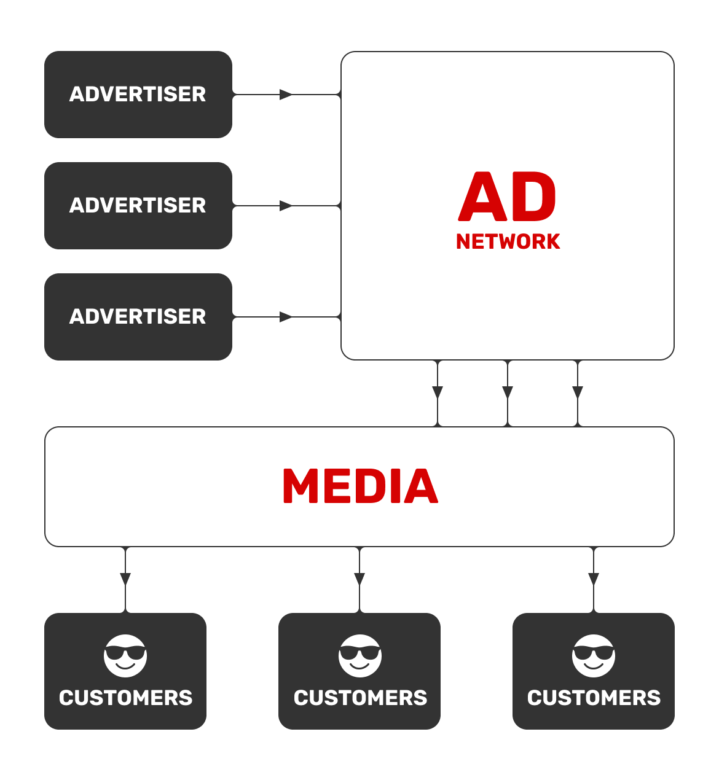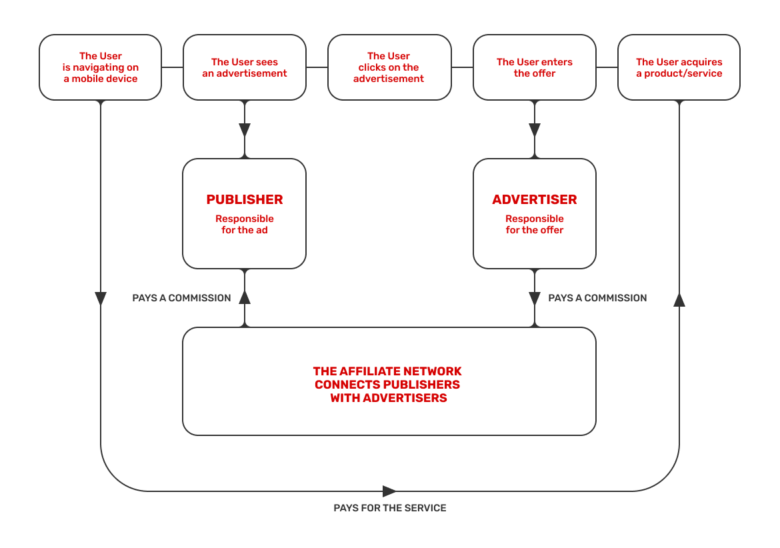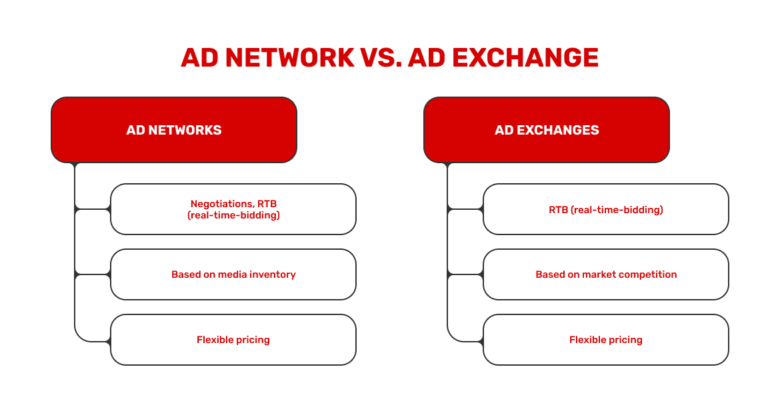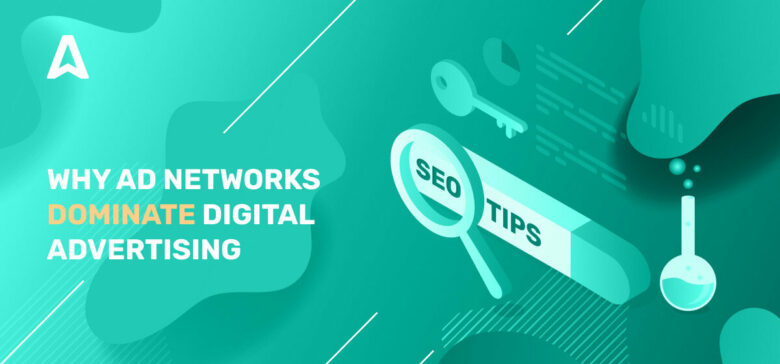Ad networks have ushered in a new era of digital advertising. They gave business owners and publishers (website and app owners) almost limitless scalability, made it easier to design and track marketing campaigns, and fueled the entire advertising industry.
In this updated blog post, we explain what ad networks are, highlight their benefits, discuss the most popular models, and help you select the best ad network for your needs.
- What is an ad network?
- How does an ad network function
- Differences between an ad server, ad network, and ad exchange
- How do ad networks benefit advertisers and publishers?
- Benefits for advertisers
- Benefits for publishers
- Types of ad networks
- Ad network examples
- What should you look for when choosing an ad network?
- 1. The size of the ad network
- 2. Quality of ads in the network
- 3. Ad formats available in the network
- 4. Payment and compensation terms
- 5. Payment period
- 6. The ad network’s basic infrastructure
- Conclusion
What is an ad network?

The first ad network emerged when online advertising was in its early stages in the mid-1990s. It helped publishers overcome market inefficiencies to sell ad space and meet advertiser demand.
Traditionally, the ad network’s job was to gather unsold ad inventory and sell it to the demand side at a much lower price than the publishers’ direct sales. This type of inventory sale is also known as remnant or non-premium.
However, modern advertising networks have evolved to take a more strategic approach to offer advertisers the best deals on the premium placement of their ads with the potential for the highest conversion rates.
How does an ad network function

- An ad network signs up publishers to meet the advertisers’ demand for ad space on an auction basis.
- The publisher installs the ad network’s tags on their site by inserting them directly into the page or via a first-party ad server.
- The advertiser sets up their campaigns directly through an ad network’s campaign management panel, including parameters like targeting, budget, bidding caps, and more.
- Once the ad is published, the advertiser can rotate multiple banners on the website with the help of the ad network’s campaign management panel.
Though the terms “an advertiser” and “a publisher” have already popped up quite a lot in this blog post, make sure you get the difference between them.

Differences between an ad server, ad network, and ad exchange

We already explained in detail the differences between these concepts here: Ad Network vs Ad Exchange vs Ad Server: Differences and Benefits. However, we’ll briefly go over ad servers and exchanges.
- An ad server is a piece of software that manages, stores, and exchanges files between those who buy traffic (to rotate ads) and those who sell the traffic (to expose ads to website visitors).
- An ad exchange is similar to an ad network in that both distribute inventory. The ad network determines the cost of an inventory spot, while ad exchanges set it through real-time bidding.
How do ad networks benefit advertisers and publishers?
Advertisers can use ad networks to connect with audiences that are tailored to their company’s goals, track the performance of ads, and adjust bid settings. Publishers can manage all of their inventory in one place and make the most of every available inventory spot.
Consider the following advantages that ad networks provide to advertisers and publishers:
Benefits for advertisers
- Access to unique traffic sources all over the world. They instantly connect business owners to millions of publishers, allowing them to expand their reach and connect with international audiences.
- Ad campaign management made easier. Ad networks offer a variety of marketing tools for creative design and campaign tracking. As a result, business owners and marketers can see exactly how much engagement each ad they pay for generates.
- Robust setup options. Advertisers can make use of a comprehensive user profile. The ability to specify the cost per click, the interests, location of desired traffic, and select the most appealing ad type for your target audience. This approach greatly increases marketing efficiency.
Benefits for publishers
- No personal interaction is required. Using ad networks instead of directly searching for advertisers allows publishers to focus on content planning and attracting as many users as possible rather than worrying about their website monetization model.
- Relevant ads appear on your site. Ad networks enable media owners to filter ads and select those relevant to the platform’s readers and do not violate editorial policies.
- Multiple monetization options. Publishers can charge advertisers on a pay-per-click, pay-per-view, pay-per-sale, pay-per-lead, or pay-per-install basis. Media owners are confident that they are maximizing the value of their inventory.
- Built-in inventory management infrastructure. Publishers benefit from a built-in supply-side platform that allows them to manage inventory and track user engagement and revenue.
Types of ad networks
- Premium ad networks. These networks have a lot of unique inventory. An advertiser has to request an invitation or pay a subscription fee to get access. Publishers need to ensure that their website meets the ad network’s traffic requirements to start distributing their inventory.
- Vertical ad networks. These are networks that are specific to a particular industry. For example, joining an IT-only ad network will give business owners a better chance of matching with relevant target audiences if they want to publish an ad on tech websites.
- Inventory-specific networks. They specialize in distributing a specific type of inventory (banner-only, video-only, mobile-only, and so on), making it easier for business owners and content platform managers to place and distribute certain types of content. Examples of such networks include Verizon Media and Taboola.
- Multi-format ad networks. These global networks serve billions of impressions per month. They offer their partners at least ten ad formats, including popunders, display banners, video pre-rolls, push notifications, and more. Advertisers can rotate multiple ad types with just one line of code. Advertisers and publishers benefit from innovative formats like Social Bar, which add a new dimension to their marketing efforts.
Ad network examples
What should you look for when choosing an ad network?
1. The size of the ad network
A larger inventory makes an ad network better at contextual targeting. Big platforms have more options when attempting to match an ad to a relevant website based on its content. For advertisers, this means better targeting results in higher user engagement and CTR rates. And for a publisher, it means more relevant and converting ads appear on your website.
A larger pool of advertisers means that a more significant number of geographic areas are represented, lowering the likelihood that a publisher’s inventory will go unsold.
2. Quality of ads in the network
From an average internet user’s perspective, ads they see on a publisher’s website are endorsed by the publisher—even if this is not the case.
Most publishers are unconcerned about the type of ads served as long as they are served (making them some money). Even if it gives good results in the short term, this could be problematic and harmful to their brand.
For example, imagine a magic weight loss pill ad appearing on a fitness blog? That is a complete betrayal of trust on the part of the website owner. And that is only the beginning of their problems; users are also less likely to click on low-quality ads, resulting in lower CTR and revenue.
3. Ad formats available in the network
Formats can significantly impact ad performance, and in this case, one size does not fit all. What works for one website may totally fail on another. Or what works for one advertiser may backfire for the other.
Ad networks provide a variety of ad formats, including standard IAB display units, custom display units, text ads, rich media ads, video, interstitials, popups, popunders, in-page push, and other proprietary formats.
If you’re unsure which of these formats to use, it’s a good idea to go with a network that offers multiple ways to display ads, so you can test them over time and see which ones work best for you.
Adsterra has many profitable and user-friendly ad formats for all types of websites.
4. Payment and compensation terms
Ad networks pay publishers using a variety of compensation methods. CPC, CPM, CPV, CPA, and fixed cost are the most common. Let us examine what they mean:
- Publishers are paid a set amount of money each time an ad unit is clicked in a cost-per-click (CPC) model.
- Publishers are paid a fixed amount for every 1,000 ad impressions in a cost-per-mille (CPM) model.
- The publisher is paid a set amount of money each time an advertiser’s video is viewed under the cost-per-view (CPV) model.
- A cost per action (CPA) model pays the publisher a set amount of money each time a user performs a specific action, such as installing software or filling out a form.
- In a fixed-cost model, the publisher sells their ad inventory for a set price for a set period.
Which pricing model works best for your website can only be determined by testing each one and comparing the revenue generated. For advertisers, each payment model depends on your campaign goals. CPM is perfect for raising brand awareness, but the CPA model is ideal for driving sales and conversions.
Joining an ad network offering multiple compensations and payment models means you won’t have to switch whenever you want to try a new model. You can simply launch a new campaign from within your current interface.
5. Payment period
Payments are typically made on Net-10, Net-15, Net -0, and Net-60 terms. The net amount is expected to be paid in full and received by the publisher within 10, 15, 30, or 60 days of the completion of the service.
A longer period does not indicate that the ad network is doing anything wrong: they might be waiting to be paid by the advertiser before passing the money on to you. But you must do your homework before joining a network. Contact a few publishers already on the network to learn about their experiences with it.
6. The ad network’s basic infrastructure
A good ad network should provide a great UI/UX experience to its users and a solid hardware infrastructure. One reason Adsterra is so popular is that it is simple to set up and run campaigns while also being extremely feature-rich.
Publishers, in particular, should look for essential features, such as an ad management system and reporting tools. Are they simple to use? Is the reporting accurate, and does it provide real-time updates? How well integrated is the payment system into the publisher interface?
Conclusion
Advertisers can simultaneously place ads across multiple platforms in milliseconds. Publishers can also sell a large number of inventory spots at once. A third-party network will provide both business and media owners with a big-picture view of their marketing and monetization strategies, thanks to a centralized management platform that eliminates the risk of becoming confused or making a miscalculated decision.
Rely on Adsterra, a reputable ad management platform, to advertise your services or monetize your web platform in a secure and transparent manner. We are known as a secure and reliable ad network, with over 25 billion people viewing our ads and thousands of publishers and advertisers collaborating on the platform.
